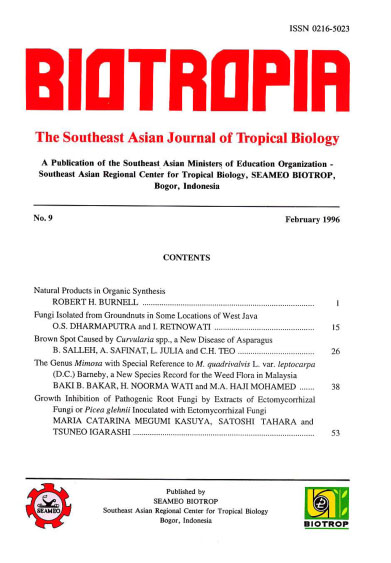
Tags
FUNGI ISOLATED FROM GROUNDNUTS IN SOME LOCATIONS OF WEST JAVA O S.DHARMAPUTRA
Content Language : English

One hundred and ninety eight groundnut samples were collected from freshly harvested groundnuts (FHG), farmer
storage systems (FSS), middlemen warehouses (MW), wholesalers (WS) and retailer sample (RS) during the dry and wet
seasons from Cidolog, Cianjur, Sukabumi and Bogor, West Java, Indonesia, in 1990/1991.
The moisture content (m.c.), intactness of kernels, and the percentages of groundnut kernels infected by each
species of fungi were analyzed.
In genera), the m.c. of the samples collected during the dry season was lower than of those collected during the
wet season. Also, the m.c. of samples collected from FHG, FSS and MW was higher than of those collected from WS and
RS.
The m.c. of samples collected from FHG was the highest (12.5-45.75%), but the percentages of damaged kernels
were the lowest (2.5-13.8%), because the samples were shelled manually.
A total of 25 species of fungi were isolated from samples collected from the 4 localities. They were
Acremonium strictum, Aspergillus candidus, A. flavus, A. niger, A. ochraceus, A. tamarii, A. wentii, Botryodiplodia
theobromae, Cladosporium cladosporioides, C. sphaerospermum, Eumtium chevalieri, E. repens, E. rubrum,
Fusarium equiseti, F. longipes, F. oxysporum, F. semitectum, Mucor sp., Papulaspora sp., Pestalotia sp., Penicillium
aethiopicum, P. citrinum, Rhizapus sp., R. stolonifer and Syncephalastrum sp.
The predominant fungi in samples collected from Cidolog and Sukabumi during the dry season were
Aspergillus wentii, while those collected from Cianjur and Bogor were A. niger.
The percentages of kernels infected by A. wentii in samples collected from Cidolog and Sukabumi were
between 30-100% and 36-100%, respectively, while those of kernels infected by A. nigerin samples collected from
Cianjur and Bogor were between 34-93% and 14-98%, respectively.
The predominant fungi in samples collected from each location during the wet season were A. flavus. The
percentage of kernels infected by the fungus in samples collected from Bogor was the highest (83-100%).

This work is licensed under a Creative Commons Attribution-NonCommercial-NoDerivatives 4.0 International License.
